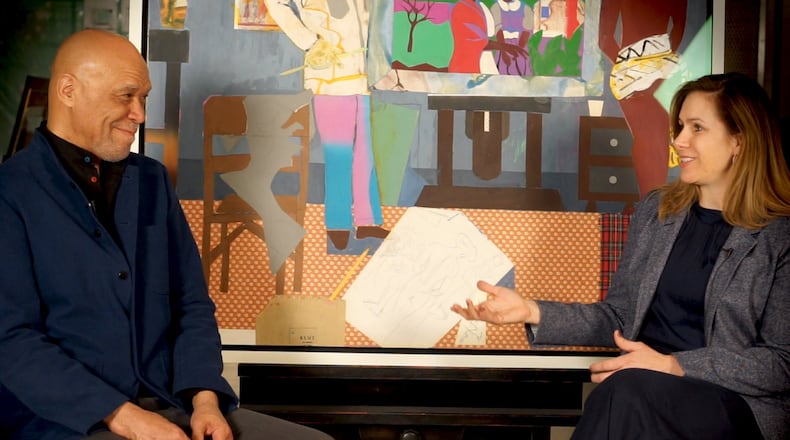In many ways artist Romare Bearden was like the Zelig of his era.
He befriended the writer James Baldwin and mingled with artists like Constantin Brancusi and Pablo Picasso. He counted “Invisible Man” author Ralph Ellison as a friend. His compatriots were his generation’s best and brightest: Billie Holiday, Louis Armstrong, Dizzy Gillespie. Duke Ellington was a family friend.
Over the course of his epic, indelible life, Bearden wrote a popular song, “Sea Breeze,” mulled becoming a professional baseball player, served in the Army, graduated NYU with an education degree, influenced legions of young black artists and was a founding member, along with Charles Alston, Hale Woodruff and Norman Lewis, of Spiral, a group of African-American artists dedicated to advocating for the civil rights movement and black art. His 1978 painting, “Mill Hand’s Lunch Bucket” (1978), inspired playwright August Wilson to pen “Joe Turner’s Come and Gone.”
The many overlaps between music and theater and the art world were the stuff of daily life in Bearden’s time coming up in ’20s-era Harlem. Bearden seemed to be everywhere there was something critical and definitive happening in America’s cultural progress at that time.
Today, Bearden’s legend persists as one of America’s most important African-American — nay, American — artists of the 20th century.
Profile begets series
Bearden’s enchanted, hard-scrabble life was chronicled in a 1977 profile in New Yorker magazine written by Calvin Tomkins. Titled “Putting Something Over Something Else,” the article offered a soup-to-nuts tribute to this remarkable man, from his childhood bouncing between Charlotte, North Carolina, and Pittsburgh, to his adulthood in Harlem’s creative incubator.
Tomkins’ story inspired Bearden — already a widely celebrated artist with work in the collections of the Museum of Modern Art, the Whitney and the Metropolitan Museum of Art — to tell his life story with his art in the “Profile” series he created after the story’s publication. Bearden exhibited “Profile” at New York’s Cordier & Ekstrom Gallery, “Part I, The Twenties” in 1979 and “Part II, The Thirties,” in 1981.
That definitive series will appear for the first time in nearly 40 years — and almost in its entirety — at the High Museum of Art. The show, "Something Over Something Else," opens Sept. 14. The title, like the name of Tomkins' profile, refers to Bearden's description of the nature of painting (and the collage process), as a matter of, literally, putting something over something else.
Part of that constructing and layering of elements was a unique aspect of the “Profile” series. Bearden wrote captions in collaboration with friend and writer Albert Murray in marker directly on the gallery walls. The effect will be recreated for the High show.
“The text and image combination is, as far as we know, unique to this project,” says the High’s curator of American art, Stephanie Heydt, who co-curated “Something Over Something Else” alongside Bearden scholar Robert G. O’Meally, an English literature professor at Columbia University.
“The captions really add a layer … they are just as important, in my mind, as the object itself,” says Heydt.
“Something Over Something Else” is about a layering of consciousness, too, says O’Meally. For Bearden, the American consciousness was like mother of pearl, composed of many sheets of identity: Anglo Saxon, black, frontiersman and Native American. “Those are the main cultural roots that make the American character,” Bearden told Tomkins.
Layers of meaning
The “Profile” series is a compelling, emotional representation of Bearden’s characteristic pop culture-infused collage form where pages from magazines and newspaper images and paint cohere into a palimpsest of memory and life’s complex march. There is “Railroad Shack Sporting House” (1978), depicting contemporary black odalisques in various states of undress in the brothels located in Bearden’s childhood neighborhood. But there are also images like “Sunset & Moonrise with Maudell Sleet” (1978), of strong, self-reliant widows who worked their farms alone, of whom Bearden wrote in his caption, “When her husband died she worked the farm, most of the time by herself.”
Those gardeners, quilt-makers, working girls and preachers from Bearden’s childhood in Charlotte and Pittsburgh were as influential for Bearden, says O’Meally, as the European artists whose work he drew inspiration from. The collages blend art history references with the folksy vernacular of Bearden’s childhood memories, creating complex meditations on black life and European art.
As Heydt notes, the series was essentially impressionistic, made up of the sensations, the shocking revelations, the small bittersweet moments of childhood.
In “Profile, Part I” Bearden recalls a childhood friend who had to pick cotton instead of play and another formative playmate, Eugene, who grew up in a brothel and taught Bearden to draw; he was dead before he turned 16. The “Profile” series is a bittersweet remembrance, like most lives are, of aching sadness and sunny days, back-breaking work and the transportive magic of music. Of his collage “Mister Blues Leaves a Calling Card” (1981), Bearden said, “you learned very early on that either side of the street could be sunny or blue.”
“Something Over Something Else” will include several drawings and a photograph by other artists, and clips from a six-hour documentary by filmmaker Nelson Breen. The film shows Bearden walking through the “Profile” series alongside the late Richard A. Long, who was a professor at Atlanta University (now Clark Atlanta University) and an influential ambassador for Atlanta’s black creative class. Bearden, O’Meally notes, had a long, productive relationship with Atlanta and with the High, which featured all of the artist’s major shows.
Acquisition spurs show
The origin of “Something Over Something Else” was the High’s acquisition in 2013 of “Artist with Painting & Model” (1981), which prompted Heydt’s desire to show the entire “Profile” series it was drawn from.
While conceptualizing the show, O’Meally’s name came up as an important voice in Bearden scholarship. He had previously curated Bearden shows at New York’s Lincoln Center in 2011 and Emory’s Michael C. Carlos Museum in 2013.
O’Meally also had the opportunity to meet Bearden while a graduate student researching a book about Ralph Ellison. Bearden was working on captioning his “Profile” series at the time.
“He was very, very quiet and unassuming,” says O’Meally. “On the other hand, he was a great storyteller. Bearden practiced a politics of generosity. He was so approachable. But so were his works. They invite you in.”
Assembling works from the “Profile” series proved challenging.
“It was like an archaeological dig” says Heydt.
After the 1979 and 1981 exhibitions, much of the work was sold and hung on walls in private homes, unseen by the public for 40 years. She was able to reunite 33 of the 47 pieces from the series.
Bearden intended to create more work in the “Profile” series, but he died before that could happen in 1988 at age 75. Nevertheless, his legacy lives on and will likely expand as new generations of admirers get to see his “Profile” series for the first time.
“The outcome is going to be people having an experience with Bearden that they haven’t had before,” says Heydt.
ART PREVIEW
'Something Over Something Else: Romare Bearden's Profile Series.' Sept. 14-Jan. 5. $14.50. High Museum of Art, 1280 Peachtree St. Atlanta. 404-733-4400, high.org
About the Author
Keep Reading
The Latest
Featured

